Jeep Compass vs Volvo EC40 – Differences & prices compared
Compare performance, boot capacity, efficiency and price at a glance.
Find out which car is the better choice for you – Jeep Compass or Volvo EC40?
Costs and Efficiency:
When it comes to price and running costs, the biggest differences usually appear. This is often where you see which car fits your budget better in the long run.
Jeep Compass has a evident advantage in terms of price – it starts at 34200 £, while the Volvo EC40 costs 46600 £. That’s a price difference of around 12420 £.
In terms of energy consumption, the advantage goes to the Volvo EC40: with 16.20 kWh per 100 km, it’s slight more efficient than the Jeep Compass with 17.50 kWh. That’s a difference of about 1.30 kWh.
As for range, the Volvo EC40 performs to a small extent better – achieving up to 584 km, about 84 km more than the Jeep Compass.
Engine and Performance:
Under the bonnet, it becomes clear which model is tuned for sportiness and which one takes the lead when you hit the accelerator.
When it comes to engine power, the Volvo EC40 has a clearly edge – offering 442 HP compared to 240 HP. That’s roughly 202 HP more horsepower.
In acceleration from 0 to 100 km/h, the Volvo EC40 is convincingly quicker – completing the sprint in 4.60 s, while the Jeep Compass takes 7.30 s. That’s about 2.70 s faster.
In terms of top speed, the Jeep Compass performs minimal better – reaching 200 km/h, while the Volvo EC40 tops out at 180 km/h. The difference is around 20 km/h.
There’s also a difference in torque: Volvo EC40 pulls convincingly stronger with 670 Nm compared to 345 Nm. That’s about 325 Nm difference.
Space and Everyday Use:
Beyond pure performance, interior space and usability matter most in daily life. This is where you see which car is more practical and versatile.
Both vehicles offer seating for 5 people.
In curb weight, Jeep Compass is clearly perceptible lighter – 1575 kg compared to 2065 kg. The difference is around 490 kg.
In terms of boot space, the Jeep Compass offers distinct more room – 550 L compared to 404 L. That’s a difference of about 146 L.
In maximum load capacity, the Jeep Compass performs a bit better – up to 1387 L, which is about 191 L more than the Volvo EC40.
When it comes to payload, Jeep Compass slight takes the win – 470 kg compared to 435 kg. That’s a difference of about 35 kg.
Who wins the race?
The Volvo EC40 proves to be wins the duel decisively and therefore becomes our DriveDuel Champion!
Volvo EC40 is the better all-rounder in this comparison.
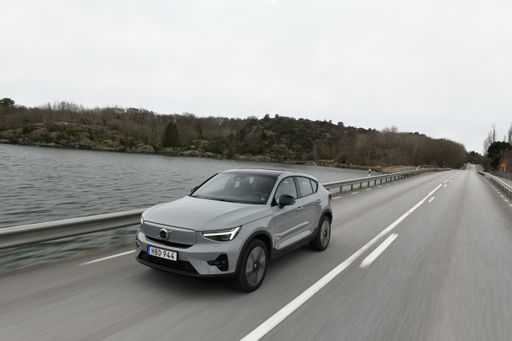
Volvo EC40
Jeep Compass
The Jeep Compass combines a rugged aesthetic with modern sophistication, making it a standout choice in the compact SUV segment. Its robust design is complemented by a comfortable interior that offers ample space and cutting-edge technology for a seamless driving experience. Whether tackling urban environments or venturing off-road, the Compass provides versatility and reliability, embodying the adventurous spirit synonymous with the Jeep brand.
details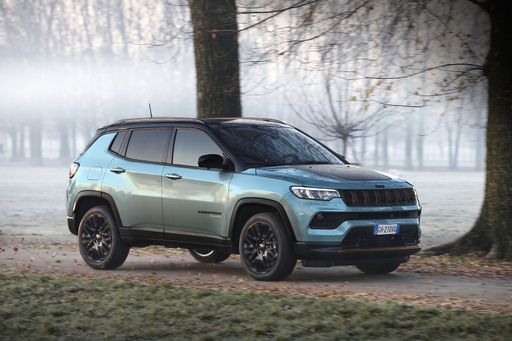 @ media.stellantis.com
@ media.stellantis.com
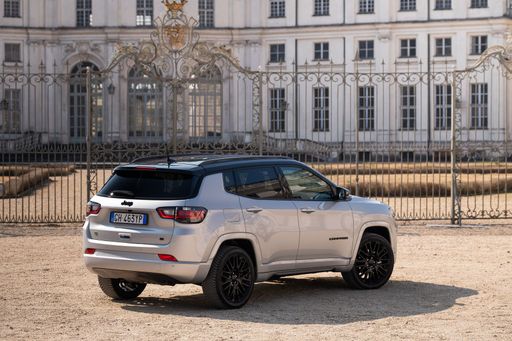 @ media.stellantis.com
@ media.stellantis.com
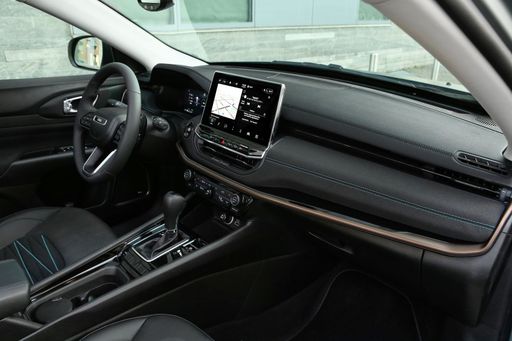 @ media.stellantis.com
@ media.stellantis.com
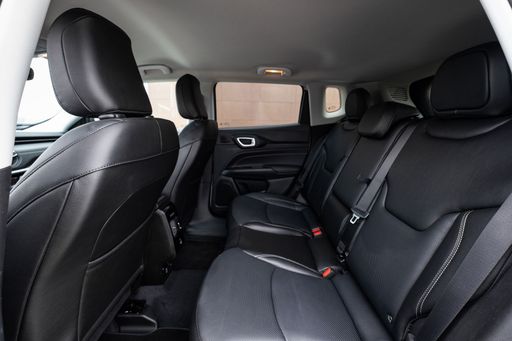 @ media.stellantis.com
@ media.stellantis.com
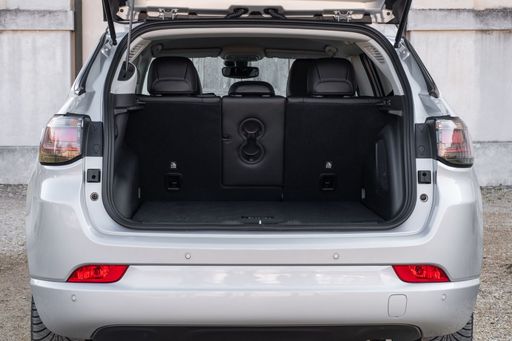 @ media.stellantis.com
@ media.stellantis.com
Volvo EC40
The Volvo EC40 seamlessly combines cutting-edge technology with sleek Scandinavian design, offering a refined driving experience. With its advanced safety features and user-friendly infotainment system, this model caters to both seasoned drivers and modern tech enthusiasts. The vehicle's impressive efficiency and environmentally conscious engineering make it a standout choice for those seeking sustainability without compromising on style.
details @ media.volvocars.com
@ media.volvocars.com

|

|
|
|
|
Costs and Consumption |
|
|---|---|
|
Price
34200 - 46900 £
|
Price
46600 - 59000 £
|
|
Consumption L/100km
2 - 5.9 L
|
Consumption L/100km
-
|
|
Consumption kWh/100km
17.50 kWh
|
Consumption kWh/100km
16.2 - 17.3 kWh
|
|
Electric Range
36 - 500 km
|
Electric Range
488 - 584 km
|
|
Battery Capacity
74 kWh
|
Battery Capacity
67 - 79 kWh
|
|
co2
0 - 133 g/km
|
co2
0 g/km
|
|
Fuel tank capacity
36 - 55 L
|
Fuel tank capacity
-
|
Dimensions and Body |
|
|---|---|
|
Body Type
SUV
|
Body Type
SUV
|
|
Seats
5
|
Seats
5
|
|
Doors
5
|
Doors
5
|
|
Curb weight
1575 - 2198 kg
|
Curb weight
2065 - 2185 kg
|
|
Trunk capacity
420 - 550 L
|
Trunk capacity
404 L
|
|
Length
4404 - 4552 mm
|
Length
4440 mm
|
|
Width
1819 mm
|
Width
1873 mm
|
|
Height
1629 - 1675 mm
|
Height
1591 mm
|
|
Max trunk capacity
1230 - 1387 L
|
Max trunk capacity
1196 L
|
|
Payload
465 - 470 kg
|
Payload
395 - 435 kg
|
Engine and Performance |
|
|---|---|
|
Engine Type
Petrol MHEV, Plugin Hybrid, Electric
|
Engine Type
Electric
|
|
Transmission
Automatic
|
Transmission
Automatic
|
|
Transmission Detail
Dual-Clutch Automatic, Automatic Gearbox, Reduction Gearbox
|
Transmission Detail
Reduction Gearbox
|
|
Drive Type
Front-Wheel Drive, All-Wheel Drive
|
Drive Type
Rear-Wheel Drive, All-Wheel Drive
|
|
Power HP
130 - 240 HP
|
Power HP
238 - 442 HP
|
|
Acceleration 0-100km/h
7.3 - 10.3 s
|
Acceleration 0-100km/h
4.6 - 7.3 s
|
|
Max Speed
180 - 200 km/h
|
Max Speed
180 km/h
|
|
Torque
230 - 345 Nm
|
Torque
420 - 670 Nm
|
|
Number of Cylinders
4
|
Number of Cylinders
-
|
|
Power kW
96 - 177 kW
|
Power kW
175 - 325 kW
|
|
Engine capacity
1199 - 1469 cm3
|
Engine capacity
-
|
General |
|
|---|---|
|
Model Year
2024 - 2025
|
Model Year
2024
|
|
CO2 Efficiency Class
D, B, A
|
CO2 Efficiency Class
A
|
|
Brand
Jeep
|
Brand
Volvo
|
What drivetrain options does the Jeep Compass have?
The Jeep Compass is available as Front-Wheel Drive or All-Wheel Drive.
The prices and data displayed are estimates based on German list prices and may vary by country. This information is not legally binding.
